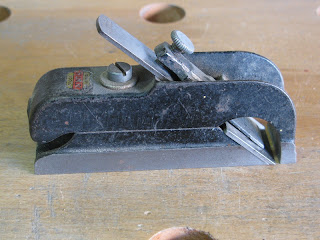There are not many positive reviews on this little rabbet plane, even anything! Today I decided to examine it more closely and verify its performances. Although a simple structure, it has an adjusting mouth. The bullnose structure, with the front part of the sole very narrow, allows the plane for using it in special situations, such as finishing a blind rabbet or working close to the intersection of stiles and rails.

 The body plane consists of two sliding parts; a screw allows to lock the parts into position and set the opening mouth to the desired width. Unfortunately, every time you perform this operation, you have to reset the blade (troublesome without a blade adjusting wheel), for which can be certainly convenient to adjust the mouth in an intermediate position and avoid too many changes. Another weak point is the lever cap; it holds the blade in its position by a thumb screw. It has little contact surface with the blade and it is quite thin and induces apprehension when the screw is tightly closed. The iron sits at 45°, bevel down, what that preferably addresses this plane for using it with the grain.
The body plane consists of two sliding parts; a screw allows to lock the parts into position and set the opening mouth to the desired width. Unfortunately, every time you perform this operation, you have to reset the blade (troublesome without a blade adjusting wheel), for which can be certainly convenient to adjust the mouth in an intermediate position and avoid too many changes. Another weak point is the lever cap; it holds the blade in its position by a thumb screw. It has little contact surface with the blade and it is quite thin and induces apprehension when the screw is tightly closed. The iron sits at 45°, bevel down, what that preferably addresses this plane for using it with the grain.
 The sides were square with the sole.
The sides were square with the sole.

 I run a plane tune up. With the blade in working position, but retracted so that it cannot cut, I lapped the sole using glass plate attached sandpaper. The blade was sharpened with a 30° bevel. For this iron type I used the Stanley sharpening guide. In these blades it's very important to obtain the cutting edge perfectly square with the sides. The lever cap was in contact with iron only to one side, making the plane practically unusable. I accurately smoothed this zone and in order to ensure a good contact I had to make a slight correction (I used a file) to the protrusions that form the lever fulcrum. The iron bedded satisfactorily.
I run a plane tune up. With the blade in working position, but retracted so that it cannot cut, I lapped the sole using glass plate attached sandpaper. The blade was sharpened with a 30° bevel. For this iron type I used the Stanley sharpening guide. In these blades it's very important to obtain the cutting edge perfectly square with the sides. The lever cap was in contact with iron only to one side, making the plane practically unusable. I accurately smoothed this zone and in order to ensure a good contact I had to make a slight correction (I used a file) to the protrusions that form the lever fulcrum. The iron bedded satisfactorily.
The final result is quite good and the plane proved to be accurate in finishing rabbets. More than one doubt remains, particularly regarding a good blade grip.
